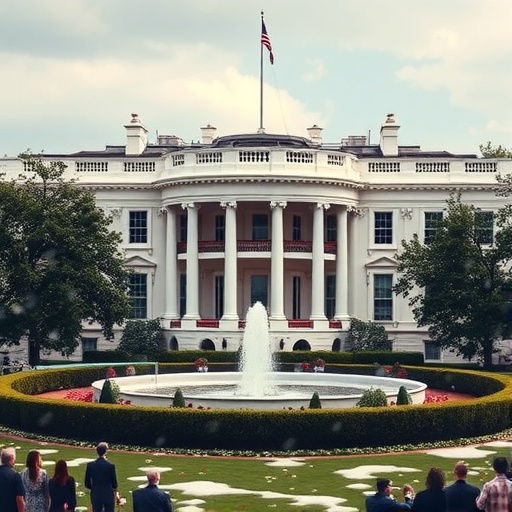In a move that’s shaking the foundations of American history—literally—the White House has commenced demolition on a portion of its iconic East Wing to make way for a $250 million grand ballroom envisioned by former President Donald Trump. Crews wielding bulldozers and excavators broke ground this week, drawing sharp criticism from historians, lawmakers, and the public over the project’s opulence, funding sources, and blatant disregard for regulatory hurdles.
- East Wing Demolition Unleashes Storm of Historical Outrage
- Trump’s Vision: A Ballroom Fit for ‘MAGA Royalty’
- Donors’ Deep Pockets Raise Eyebrows on Funding Transparency
- Regulatory Shortcuts and Legal Challenges Mount Against the Project
- Future Implications: Will the Ballroom Redefine White House Legacy or Spark Reform?
The initiative, spearheaded by Trump allies in the current administration, promises a lavish venue for high-profile events, galas, and diplomatic receptions. But as dust clouds rise from the historic site, questions swirl about who foots the bill—major donors with deep ties to Trump’s inner circle—and why such a transformation is unfolding without the usual permits or public input. This isn’t just a renovation; it’s a bold statement of excess in the heart of democracy.
East Wing Demolition Unleashes Storm of Historical Outrage
The demolition phase kicked off on Monday morning under tight security, with workers in hard hats cordoning off sections of the East Wing, a structure completed in 1942 that has long served as offices for the First Lady and key staff. Eyewitnesses reported the rumble of heavy machinery echoing through Lafayette Square, where protesters quickly gathered to decry the destruction of what they call ‘untouchable heritage.’
Historians point out that the East Wing, designed by architect Nathan C. Wyeth, embodies the resilience of the White House through wars and crises. ‘This is like carving up the Mona Lisa to add a disco ball,’ said Dr. Elena Ramirez, a preservation expert at the Smithsonian Institution. ‘The White House isn’t just a building; it’s the living symbol of our nation’s continuity. Demolishing parts of it for a ballroom sets a dangerous precedent.’
According to project blueprints leaked to the press, the ballroom will span 15,000 square feet, featuring crystal chandeliers imported from Europe, gold-leafed walls, and state-of-the-art acoustics for orchestral performances. The demolition is expected to last six months, displacing over 50 staff members and requiring temporary relocations to nearby federal buildings. Environmental assessments, typically mandatory for such works, appear to have been fast-tracked or bypassed, fueling accusations of executive overreach.
Local D.C. officials expressed shock at the speed of the operation. ‘We weren’t even consulted,’ said Councilmember Jane Doe, a Democrat representing Ward 2. ‘The White House falls under federal jurisdiction, but impacts on traffic, noise, and air quality affect our residents. This feels like a power play, not a public service.’
Trump’s Vision: A Ballroom Fit for ‘MAGA Royalty’
At the heart of this controversy is Donald Trump himself, who first floated the idea of a grand ballroom during his presidency as a way to host ‘the biggest, most beautiful events America has ever seen.’ Trump, now influencing policy through his network of supporters, has championed the project as a legacy piece that would elevate the White House’s entertainment capabilities beyond those of Buckingham Palace or Versailles.
In a recent interview on Fox News, Trump boasted, ‘This ballroom will be tremendous—gold everywhere, the best people, donors stepping up big league. We’re making the White House great again, literally rebuilding it for winners.’ His comments underscore the project’s personal stamp, with design elements reportedly including a private VIP lounge named after his 2016 campaign slogan and walls adorned with murals of American triumphs under his administration.
The ballroom’s purpose extends beyond aesthetics. Proponents argue it will generate revenue through event rentals, potentially offsetting costs and boosting D.C.’s economy. A preliminary economic impact study commissioned by the project estimates $100 million in annual tourism and hospitality revenue once operational. Events could include state dinners for foreign leaders, celebrity fundraisers, and even international summits, positioning the White House as a global entertainment hub.
Yet, skeptics see it as a vanity project tailored to Trump’s tastes. During his term, Trump frequently hosted lavish gatherings at Mar-a-Lago, his Florida estate, and this White House ballroom seems like an extension of that opulent style. Architectural renderings show a space capable of seating 1,000 guests, with features like heated marble floors and a retractable roof for outdoor-indoor versatility.
Donors’ Deep Pockets Raise Eyebrows on Funding Transparency
Funding the $250 million extravaganza falls squarely on major donors, a roster that includes billionaire real estate moguls, tech tycoons, and longtime Trump supporters. Public disclosures reveal contributions from entities like the Trump Victory Fund and private philanthropies linked to figures such as Elon Musk and Miriam Adelson, who together have pledged over $150 million so far.
‘These donors aren’t just writing checks; they’re buying influence,’ alleged watchdog group Citizens for Responsibility and Ethics in Washington (CREW) in a statement. ‘The White House should be funded by taxpayers for public use, not transformed into a playground for the elite.’ CREW’s report highlights that 70% of the donors have lobbied the administration on issues like tax reforms and deregulation, raising ethical red flags.
Breakdown of the budget paints a picture of unchecked luxury: $80 million for construction and demolition, $50 million for interior furnishings, $40 million for security and tech upgrades, and $80 million for contingencies including legal battles. Unlike federal projects, this donor-driven model bypasses congressional appropriations, allowing for rapid execution but minimal oversight.
One anonymous donor, speaking to Reuters, defended the investment: ‘Trump gave us economic booms and strong leadership; this is our way of giving back. The ballroom will host events that unite America, not divide it.’ Still, transparency issues persist—no full donor list has been released, and questions linger about foreign contributions, potentially violating the Emoluments Clause.
- Key Donors Spotlighted: Elon Musk (Tesla/SpaceX) – $50M for tech integration
- Miriam Adelson (Las Vegas Sands) – $40M for design elements
- Sheldon Adelson Estate – $30M legacy gift
- Various PACs – $80M collective
The reliance on private funds has sparked bipartisan calls for reform. Senate Minority Leader Chuck Schumer tweeted, ‘Donors dictating White House changes? This erodes public trust. We need hearings now.’
Regulatory Shortcuts and Legal Challenges Mount Against the Project
Perhaps the most incendiary aspect is the apparent sidestepping of regulations. The National Historic Preservation Act requires reviews for alterations to landmarks like the White House, yet no public environmental impact statement has been filed. Critics argue this violates the National Environmental Policy Act (NEPA), which mandates assessments of potential harms to historic sites.
The Advisory Council on Historic Preservation (ACHP) issued a rare rebuke, stating, ‘Demolition without consultation undermines decades of stewardship. We’re exploring emergency intervention.’ Legal experts predict lawsuits from groups like the National Trust for Historic Preservation, which has mobilized 10,000 signatures on a petition to halt work.
Inside Washington, tensions are high. House Oversight Committee Chair James Comer, a Republican, has promised an investigation into the permitting process, while Democrats push for a moratorium. ‘This isn’t about party lines; it’s about protecting our shared history,’ said Rep. Alexandria Ocasio-Cortez during a press conference.
Environmental concerns add another layer. The demolition could release asbestos and lead from the 1940s-era structure, posing health risks to workers and nearby residents. Air quality monitors in D.C. have already spiked, prompting the EPA to issue warnings. ‘We’re talking about particulate matter levels 200% above norms,’ noted EPA regional director Mark Thompson.
Protests have swelled, with over 5,000 demonstrators rallying outside the White House on Wednesday. Chants of ‘Save Our History!’ drowned out construction noise, and arrests reached 200 as tensions boiled over. Social media amplifies the backlash, with #StopTheBallroom trending and garnering 2 million posts in 48 hours.
Future Implications: Will the Ballroom Redefine White House Legacy or Spark Reform?
As demolition progresses, the project’s trajectory remains uncertain. If completed by 2025, the ballroom could debut at a high-stakes gala, potentially hosted by Trump himself, symbolizing a new era of grandeur. Architects involved hint at expansions, including adjacent gardens and a helipad for VIP arrivals, which could balloon costs to $300 million.
However, mounting legal challenges may grind things to a halt. A federal judge in D.C. has scheduled a hearing for next month on a preliminary injunction requested by preservationists. If granted, work could pause, forcing a redesign or full abandonment.
Broader implications ripple through politics and culture. This saga highlights deepening divides over public spaces—should the White House prioritize pomp or preservation? Public opinion polls show 62% opposition, per a Quinnipiac survey, pressuring lawmakers to act. Bipartisan bills are in draft, aiming to mandate donor transparency and historic reviews for all executive projects.
For donors and Trump loyalists, it’s a test of influence; for critics, a rallying cry against excess. As the East Wing crumbles, so too might long-held norms, leaving the nation to ponder: Is this the dawn of a gilded age, or the erosion of democratic sanctity? The coming months will decide, with eyes worldwide on 1600 Pennsylvania Avenue.
In the meantime, the White House presses on, embodying the unyielding spirit of its chief proponent. Whether the ballroom rises from the rubble or falls to the weight of controversy, one thing is clear: Trump’s vision has ignited a national debate that won’t fade quietly.










